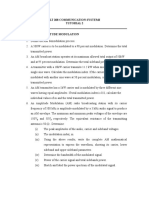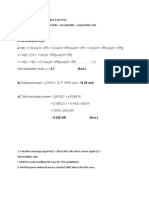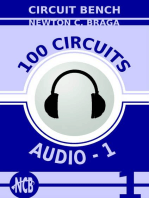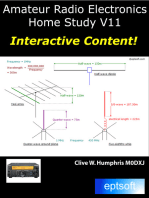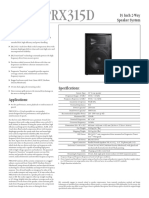Practice Problems For Chapter 5 and 6
Practice Problems For Chapter 5 and 6
Uploaded by
Mark Asesor CalonzoCopyright:
Available Formats
Practice Problems For Chapter 5 and 6
Practice Problems For Chapter 5 and 6
Uploaded by
Mark Asesor CalonzoOriginal Description:
Original Title
Copyright
Available Formats
Share this document
Did you find this document useful?
Is this content inappropriate?
Copyright:
Available Formats
Practice Problems For Chapter 5 and 6
Practice Problems For Chapter 5 and 6
Uploaded by
Mark Asesor CalonzoCopyright:
Available Formats
5.
4 Practice Problems
1) For an AM DSBFCwave with a peak unmodulated voltage of 10 V and a load
resistance of 100, the glven modulation index is 0.5. Determine the
following:
a) The carrier and the sideband power
b) The total power
c) The percent power of the information
d) The power spectrum
2) Calculate the percentage power saving when the carrier and one of the
sidebands is suppressed in an AM signal if the modulation index is a) 100%
and b) 25%.
93
LESS (Clf . J 5 5IA'L'J Le, S l.d~{)1A//lA~_ ; . / . l I |
"-'._Dl~IfSI.u:.~~t"".,ftf.;~~~:m~~;>Ij,~iIj".>'~iJ~~~~"~;~~~wi.I..-.u~:.~~ii:Q;;ii.ifr:ii
3) For a SOO--Wcarrier modulated to -3 depth of gOq~J I find tile total power ano
the ~1op.s in each of the follmving forms of /,.,ivL
a) BE
b) H3E
c) DSB
----------------------------------------
---------,--------
------------------------------_._-----------
4) An A~'"wave has a totai transmitted power of 4 kW when modulated at 85%.
How much total power should an SSBwave contain in order to have the same
power content as that in the two sidebands?
94
5) If a transmitter power of 100 W is sufficient for reliable communication over a
certain path using the SSB, approximately what power level would be required
using the H3E?
6) What is the maximum modulating signal frequency that can be used in a J 3E
system with a SO-kHz bandwidth?
7) A filter-type, SSB generator uses an ideal bandpass filter. with a center
frequency of 5.000 MHz and a bandwidth of 2.7 kHz. What frequency should
':..,
be used for the carrier oscillator if the generator is to produce a L SB signal
with a baseband frequency response having a lower limit of 280 Hz?
8) An SSBSC signal has a suppressed carrier frequency of 2MHz. It is modulated
with two audio tones having frequencies of 1500 and 2200 Hz. The receiver is
mistuned so that the BFO is at 1.9995MHz. What will be the output
frequencies of the demodulator if the signal is L SB?
95
9) A J 3E transmitter operating at 16 MHz has a frequency stability of 1 part per
million. If its transmission is reproduced by a receiver whose frequency
stability is 8 parts per million, what is the maximum frequency error of the
output of this receiver in reproducing this transmission?
10) The CB radio was developed using a full-carrier DSB AM. It operates using
40 channels, each 10 kHz wide. When the SSBSCis used, the same carrier
frequencies are used as with the conventional AM, but the transceivers are
switchable to either a lower or an upper sideband. How many channels are
available when the SSBis used?
11) What is the power saving of a double sideband full carrier AM signa! at 50%
modulation, if the emission used is J 3E?
96
12) What is the maximum modulating signal frequency that can be used with a
H3Esystem with 50-kHz bandwidth?
13) An AM transmission 1000W is fully modulated. Calculate the power
transmitted if it is transmitted as a SSBsignal.
14) A SSB transmission drives llO-Vpk into a 75-0 antenna. Calculate the PEP.
15) An SSBtransmitter has a PEP 10 kW, what is the average power?
97
ZNX'
6.5 Practice Problems
1) A TRF receiver. is to be designed with a single tuned circuit using a 20-/-lH
inductor.
a) Calculate the capacitance range of the variable capacitor required to
tune from 535-1605 kHz.
b) The ideal 10-kHz bandwidth is to occur at 1000kHz. Determine Q.
c) Calculate the bandwidth of this receiver at 535 kHz and at 1605 kHz.
2) For an AM receiver that uses high-side injection and has a local oscillator
frequency of 1455 khz, determine the IF carrier upper side frequency and
lower side frequency for an RF signal that is made up of a carrier, an
upper and a lower side frequencies of 1000 kHz, 1005 kHz, 995 kHz,
respectively. .
108
3) A receiver tunes the 300 kHz to 3 MHz MF band in one range, using an IF
of 35.75 MHz. Calculate the range of oscillator frequencies and the range
of image frequencies.
4) What is the local oscillator frequency range in the commercial AM
broadcast if the IF isequal to 455 kHz?
109
U'5lU1iiW _
-
5) Determine the image frequency of a broadcast band receiver using a 455
kHz IF tuned to 630 kHz - DZfvlM.
6) Determine the local oscillator frequency of a broadcast band receiver
using a 455-kHz IF tuned at 630 kHz.
-------------_._-
.--------------- ---
7) For a receiver with IF~RF, and local oscillator frequencies of 455 kHz, 630
kHz and 1085 kHz, respectively, determine the:
a) image frequency.
b) IFRR for a pre-selector Qof 80.
---------_._._------_ ..__._---- -.----
-------_._._------_._--
-----_.------.--.~-~---.----.-------------,--.-..-----.-.----.----.----------~--.....-
8) A superheterodyne receiver is tuned to a frequency of 10 MHz when the
local oscillator frequency is 12.5MHz.
a) What is the IF?
b) Which type of injection is in use?
9) One receiver has a sensitivity of 1 /-L V and another has a sensitivity of 10-
dBf under the same measurement conditions. Both receivers have an
input impedance of 750. Which receiver is more sensitive?
10)A receiver has a sensitivity of 0.75 ~V and a blocking dynamic range of
80 dB. What is the strongest signal that can be present along with a
O.75-~V signal without any blocking/desensitization taking place?
111
11) For an AM receiver tuned to a station at 590kHz with IF=455 kHz,
calculate the image frequency rejection in dB. Assume that the input filter
consists of one tuned circuit with a Qof 40.
12) A superheterodyne receiver having an RF amplifier and an IF of 10.6 MHz
is tuned to 90.7MHz. Calculate the Q's of the RF and mixer input tuned
circuits, both being the same, if the receiver's overall image rejection is to
be 100.
13) Determine the net receiver gain for an AM receiver with an RF input
power of -88 dB
m
and an audio signal of 12 dB
m
-------
112
14) A receiver for a signal at 150 MHz uses a iO.7-MHz IF and low tracking.
Calculate the L O frequency and the image frequency.
15) A receiver intended for the aircraft to control tower signals at 110 MHz
uses double conversion, with 10.7 MHz and 455-kHz IFs. Calculate the
following if the receiver employs low tracking: a) L O frequencies, b)
frequencies after using the 1st mixer, c) output of the 2nd mixer, d)
image frequency.
113
You might also like
- Amfm Ceit 29 402aDocument2 pagesAmfm Ceit 29 402aJee-han HanNo ratings yet
- ECEA111 Exam 2 ReviewerDocument4 pagesECEA111 Exam 2 ReviewerJulia GuintoNo ratings yet
- EstDocument4 pagesEstGeorge Ezar N. Quiriado100% (1)
- DVD Home Theatre System: DAV-HDX500/HDX501WDocument120 pagesDVD Home Theatre System: DAV-HDX500/HDX501WchrideerNo ratings yet
- Numerical ProblemsDocument3 pagesNumerical ProblemsMANISH KUMAR100% (1)
- ConclusionDocument1 pageConclusionMark Asesor Calonzo100% (1)
- Blake Problem ComputationDocument3 pagesBlake Problem ComputationNiño del Mundo75% (4)
- Question Bank For Test 2Document3 pagesQuestion Bank For Test 2api-194677273No ratings yet
- Blake Problem ComputationDocument3 pagesBlake Problem ComputationFrew FrewNo ratings yet
- Problems On Principle of CommunicationsDocument2 pagesProblems On Principle of Communicationsnicdocu100% (1)
- Blake ProblemsDocument5 pagesBlake ProblemsScot VigiliaNo ratings yet
- CTRL F GodDocument13 pagesCTRL F GodNichole BalagatNo ratings yet
- Apc Assignment 1: F 100 KHZ A. B. C. D. R 10 1 A. B. C. D. E. 0.5Document2 pagesApc Assignment 1: F 100 KHZ A. B. C. D. R 10 1 A. B. C. D. E. 0.5Priya AnandNo ratings yet
- Blake Problem ComputationDocument3 pagesBlake Problem ComputationMark Go0% (1)
- Comms by Blake Computation ProblemsDocument3 pagesComms by Blake Computation ProblemsShebNo ratings yet
- POC Problem Set Noise and AMDocument1 pagePOC Problem Set Noise and AMMike BunquinNo ratings yet
- Amplitude ModulationDocument1 pageAmplitude ModulationKuronix ArcayaNo ratings yet
- PcsDocument2 pagesPcssr635597No ratings yet
- Question Bank (I and II)Document4 pagesQuestion Bank (I and II)Anonymous 4u5XkWGONo ratings yet
- Tutorial Sheet 03Document2 pagesTutorial Sheet 03Mr. Praveer SaxenaNo ratings yet
- PGT 212 / Electronic Communication Tutorial: Amplitude ModulationDocument2 pagesPGT 212 / Electronic Communication Tutorial: Amplitude ModulationELLAINE DE CLARONo ratings yet
- Assignment 1Document1 pageAssignment 1sujithaNo ratings yet
- Communication Suggestion For EEE Job PreparationDocument19 pagesCommunication Suggestion For EEE Job PreparationAbdul Hannan50% (2)
- Analog CommunicationsDocument6 pagesAnalog CommunicationsSri KrishnaNo ratings yet
- AahhDocument6 pagesAahhإبراهيم محمد عليNo ratings yet
- ModulationDocument7 pagesModulationSyeda MiznaNo ratings yet
- Analog CommunicationsDocument3 pagesAnalog CommunicationsjonahNo ratings yet
- AC Tutorial QuestionsDocument3 pagesAC Tutorial QuestionsranddconsultancyNo ratings yet
- Est SolvingDocument3 pagesEst SolvingPaolo Santos AntonioNo ratings yet
- Am ModulationDocument5 pagesAm ModulationChittira Manoharen100% (2)
- 6 Tute Sheets ACSDocument6 pages6 Tute Sheets ACSAman KumarNo ratings yet
- Munication Engineering ..Topic 9 BitsDocument47 pagesMunication Engineering ..Topic 9 BitsSrilekhaNo ratings yet
- AllProblemSets PDFDocument16 pagesAllProblemSets PDFMaxamed CabdiraximNo ratings yet
- Worksheet #1Document3 pagesWorksheet #1abdi gmNo ratings yet
- Analog Communications Question BankDocument10 pagesAnalog Communications Question BankSsgn Srinivasarao100% (1)
- 3C5 Tutorial Sheet 6: Dr. David Corrigan 18 March 2011Document5 pages3C5 Tutorial Sheet 6: Dr. David Corrigan 18 March 2011Naresh KadyanNo ratings yet
- Sample AM NumericalsDocument4 pagesSample AM NumericalsDisha GoelNo ratings yet
- Tutorial Chapter 2Document4 pagesTutorial Chapter 2zulNo ratings yet
- Multiple ChoiceDocument3 pagesMultiple Choicemary_nailynNo ratings yet
- Satyam College of Engineering and Technology, Aralvoimozhi Ece Iv-Semester Revision Questions Electronic Circuits Ii 2 Mark Questions Revision IDocument4 pagesSatyam College of Engineering and Technology, Aralvoimozhi Ece Iv-Semester Revision Questions Electronic Circuits Ii 2 Mark Questions Revision ISaranya MohanNo ratings yet
- 3ECE-AC Lab ManualDocument62 pages3ECE-AC Lab ManualShannon DunnNo ratings yet
- Am ProblemsDocument3 pagesAm ProblemsSHYAMNo ratings yet
- Rmohn ELEN4314 Project ReportDocument10 pagesRmohn ELEN4314 Project Reportjackal1710No ratings yet
- Amplitude Modulation - ProblemsDocument2 pagesAmplitude Modulation - ProblemsSHYAM100% (1)
- Amplitude Modulation MCQDocument20 pagesAmplitude Modulation MCQgunasekaran k100% (2)
- A Modulating Signal MDocument6 pagesA Modulating Signal MxepilNo ratings yet
- Refest 2 DebDocument6 pagesRefest 2 DebgiophilipNo ratings yet
- EC 2305 Novl 2010 Solved TwoMarksDocument4 pagesEC 2305 Novl 2010 Solved TwoMarksgurugovanNo ratings yet
- CT QBDocument23 pagesCT QBRishikesh BhavsarNo ratings yet
- Quetion Bank Ecom Week WiseDocument3 pagesQuetion Bank Ecom Week WiseHet PatelNo ratings yet
- CommunicationsDocument6 pagesCommunicationsDenaiya Watton LeehNo ratings yet
- Principles of Communications AM Ppt2Document24 pagesPrinciples of Communications AM Ppt2lanzNo ratings yet
- Part-A: Analog and Digital Communication-Ec1291Document3 pagesPart-A: Analog and Digital Communication-Ec1291Hema VathyNo ratings yet
- Multiple Choice Questions and Answers On Amplitude ModulationDocument22 pagesMultiple Choice Questions and Answers On Amplitude ModulationDurga Bhavani Alanka100% (1)
- ReviewerDocument26 pagesReviewerIroha IsshikiNo ratings yet
- Analog Communication Practce QuestionsDocument6 pagesAnalog Communication Practce QuestionsDisha GoelNo ratings yet
- Exercise 1: 3. A Frequency of 27 MHZ Has A Wavelength of Approximately 11 MDocument5 pagesExercise 1: 3. A Frequency of 27 MHZ Has A Wavelength of Approximately 11 Mrafael aedrianne marasiganNo ratings yet
- Assignment3 SolutionsDocument12 pagesAssignment3 SolutionsabaalharthiNo ratings yet
- Exp2 Tronix1Document2 pagesExp2 Tronix1Mark Asesor CalonzoNo ratings yet
- MECDYNAMICSDocument15 pagesMECDYNAMICSMark Asesor CalonzoNo ratings yet
- Differential EquationDocument2 pagesDifferential EquationRegina Amor DandanNo ratings yet
- OBLICON Super ReviewerDocument110 pagesOBLICON Super ReviewerStefan Salvator81% (16)
- Law of Growth and DecayDocument3 pagesLaw of Growth and DecayMark Asesor CalonzoNo ratings yet
- Job Hazard AnalysisDocument1 pageJob Hazard AnalysisMark Asesor CalonzoNo ratings yet
- Jonas Hellborg Signatures M A N U A L: Warwick AmplificationDocument32 pagesJonas Hellborg Signatures M A N U A L: Warwick AmplificationDinis MartinsNo ratings yet
- Published by DB 0 946 Service Audio Printed in The Netherlands Subject To ModificationDocument34 pagesPublished by DB 0 946 Service Audio Printed in The Netherlands Subject To ModificationCarmine Del PreteNo ratings yet
- For Checking CD Players and CD DrivesDocument2 pagesFor Checking CD Players and CD DrivesSantiago DiosdadoNo ratings yet
- PRX315D: 15 Inch 2-Way Speaker System Key FeaturesDocument2 pagesPRX315D: 15 Inch 2-Way Speaker System Key FeaturesLucas LucasNo ratings yet
- Hfe Nakamichi Soundspace 5 Flyer enDocument2 pagesHfe Nakamichi Soundspace 5 Flyer enOcta Dos100% (1)
- User Manual 1249247Document5 pagesUser Manual 1249247robertNo ratings yet
- Lab Assignment 5 PocDocument6 pagesLab Assignment 5 PocZabeehullahmiakhailNo ratings yet
- 16, 22, 22MTK User Manual 16, 22, 22MTK User Manual 16, 22, 22MTK User Manual 16, 22, 22MTK User ManualDocument2 pages16, 22, 22MTK User Manual 16, 22, 22MTK User Manual 16, 22, 22MTK User Manual 16, 22, 22MTK User ManualArthur BaltharNo ratings yet
- Transmisor Steren FMT-500Document2 pagesTransmisor Steren FMT-500Alberto LimónNo ratings yet
- Jimi Hendrix ExperienceDocument28 pagesJimi Hendrix ExperienceVladislav Juric- DzuboNo ratings yet
- Stage Monitor Speakers Ahuja SMS 450 Speakers RS. 19,633Document5 pagesStage Monitor Speakers Ahuja SMS 450 Speakers RS. 19,633samruddhiu26No ratings yet
- Mesa Boogie Basis - M-2000Document16 pagesMesa Boogie Basis - M-2000FouquetNo ratings yet
- KA1102 ManualDocument20 pagesKA1102 ManualJeffNo ratings yet
- CHIRP Guide PDFDocument2 pagesCHIRP Guide PDFTiago AtomikNo ratings yet
- DataSheet TX30 TX300 CTE BroadcastDocument5 pagesDataSheet TX30 TX300 CTE BroadcastRaul Angel Perez AbadNo ratings yet
- Installation Instructions: SP-204A-25 SP-204A-70 SP-104A-25 SP-104A-70Document2 pagesInstallation Instructions: SP-204A-25 SP-204A-70 SP-104A-25 SP-104A-70Alejandro CabreraNo ratings yet
- DerkReefman DSD Wp-2323Document50 pagesDerkReefman DSD Wp-2323Caohien TranNo ratings yet
- Mixing On Headphones - SonarworksDocument1 pageMixing On Headphones - SonarworksAn D RewNo ratings yet
- Gain Staging - The Bank Account of Your Mix PDFDocument15 pagesGain Staging - The Bank Account of Your Mix PDFSteveJonesNo ratings yet
- BroadcastingDocument2 pagesBroadcastingabidansarialiNo ratings yet
- 1904 HF V UHF All Mode ENGDocument28 pages1904 HF V UHF All Mode ENGAchmad Arizki KosasihNo ratings yet
- New Low-Power Single Sideband Circuits: Philips SemiconductorsDocument10 pagesNew Low-Power Single Sideband Circuits: Philips SemiconductorsEne AlexandruNo ratings yet
- Music Tech Focus - Mastering Volume 4Document132 pagesMusic Tech Focus - Mastering Volume 4Moi100% (1)
- DR-638HE: Dual-Band Mobile Transceiver With Full Duplex CapabilityDocument2 pagesDR-638HE: Dual-Band Mobile Transceiver With Full Duplex CapabilityChris GuarinNo ratings yet
- VX602,1502,2002,3002,4002,6002,2004,3004,4004,6005Document14 pagesVX602,1502,2002,3002,4002,6002,2004,3004,4004,6005Alex GeleverNo ratings yet
- TMA Mixing On Headphones GuideDocument18 pagesTMA Mixing On Headphones Guidearmanto tupizaNo ratings yet
- Studio Recording and DawsDocument49 pagesStudio Recording and DawsDaniel ZitzmannNo ratings yet
- EACAN Price List 1st OCT 2012 (New)Document4 pagesEACAN Price List 1st OCT 2012 (New)Syahril Adzim Md RejabNo ratings yet
- Eventide H9 Max Factory Presets ListDocument5 pagesEventide H9 Max Factory Presets ListStephen E CraneNo ratings yet

























